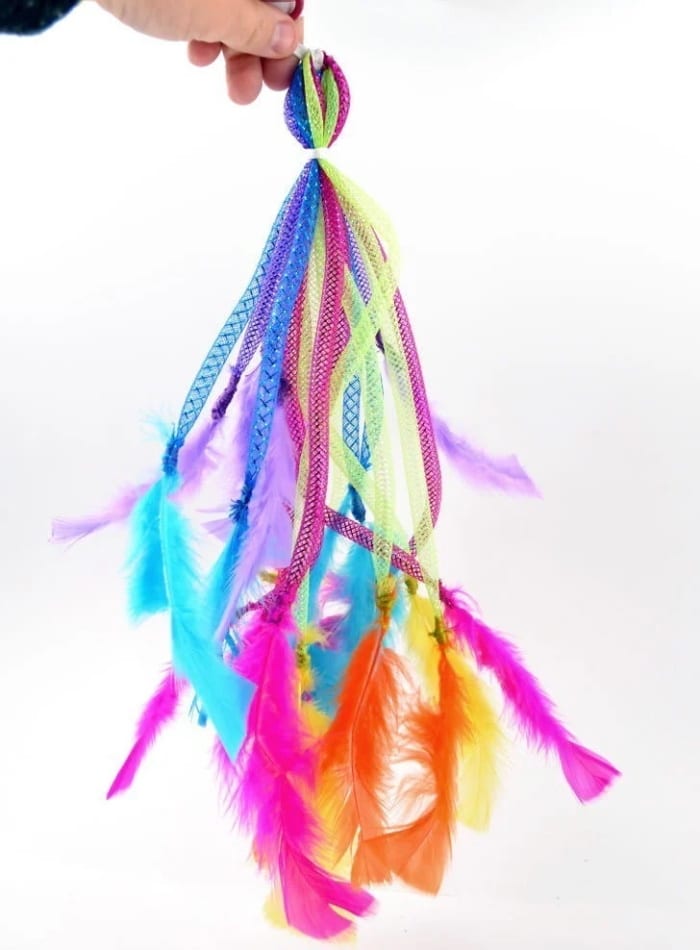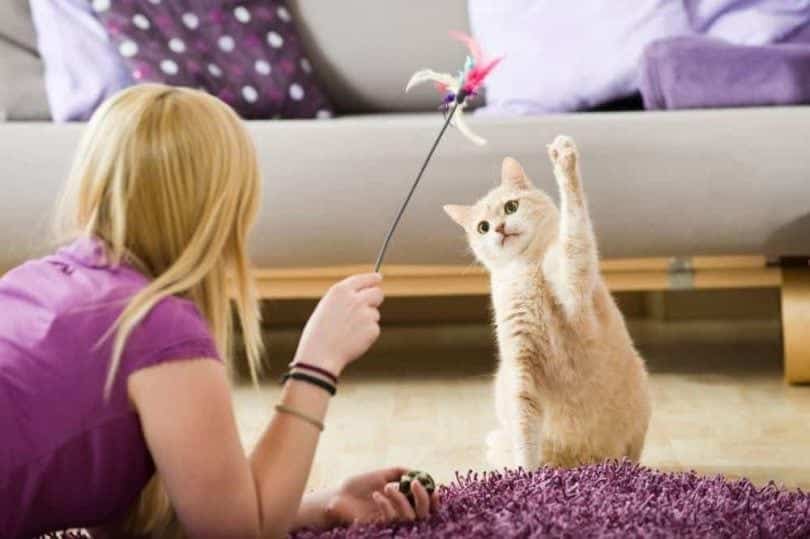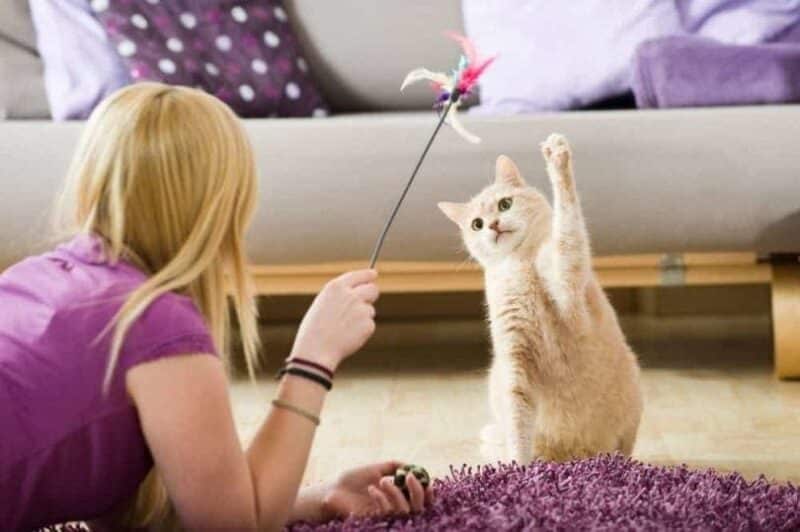Feather toys are extremely popular with cats, and it’s easy to get your kitty into a playful mood with one. However, cats can tear them up quickly with rough play, which can cause them to get quite expensive if you keep buying them at the local pet store.
Fortunately, it’s not difficult to build DIY feather toys using inexpensive items that you might already have around the house. If you enjoy doing simple crafts, keep reading for a list of several projects that you and your pet are sure to love.
The 10 DIY Feather Cat Toys
1. DIY Feather Cat Toy

| Materials: | Wooden dowel, feathers, small bells, string |
| Tools: | Glue, tape |
| Difficulty: | Easy |
The DIY Feather Cat Toy is an easy-to-build project that is also great fun. It only requires a few items, including feathers and string, and you can customize it in many ways. Bells can help make the project even more colorful and will help attract your pet when it’s playtime. The finished product is quite durable and will likely last several play sessions.
2. Easy Feather Cat Toy

| Materials: | Feathers, feather boa, string |
| Tools: | Glue, tape |
| Difficulty: | Easy |
The plan for Easy Feather Cat Toy uses an inexpensive feather boa to make it easy to find several feathers of similar quality and color. The plan walks you through bunching up the feathers to create your play toy and provides tips on using non-toxic materials.
3. DIY Wine Cork Cat Toy

| Materials: | Feathers, cork, pipe cleaners |
| Tools: | Glue, tape |
| Difficulty: | Easy |
The DIY Wine Cork Cat Toy is a fun project that shows you how to create small mouse-like toys out of feathers and corks that your pet will love to chase around the house. You can customize them in many ways by using other items, like pipe cleaners, which can make these toys more colorful and more entertaining for your pet.
4. DIY Natural Feather Cat Toy
| Materials: | Chicken feathers, twine, ribbon |
| Tools: | Paper clip, electrical tape |
| Difficulty: | Easy |
The DIY Natural Feather Cat Toy is a great project for people with access to a chicken coop. It shows you how to take the natural feathers and turn them into a toy that your pet will enjoy chasing and playing with. The natural odor can also help your pet be more interested in it, and you won’t need to worry about harmful chemicals or dyes.
5. Kirsten’s Feather Cat Toys
| Materials: | Feathers, paper towel rolls |
| Tools: | Glue, scissors |
| Difficulty: | Easy |
Kristen’s Feather Cat Toys is a wonderful project that uses common household items like paper towel rolls to create usable cat toys that your pet will enjoy, so you get to do a bit of recycling. You can also customize the toys to your liking with different colored feathers, and they are fun to build with children.
6. DIY Feather Wand Cat Toy
| Materials: | Wooden dowels, feathers, paper plate, bells |
| Tools: | Non-toxic glue, scissors |
| Difficulty: | Easy |
The DIY Feather Wand Cat Toy is a fun project that is sure to result in one of your pet’s favorite toys. Cats love to chase after it, and it doesn’t require much work on your end to get a reaction. This toy is customizable, colorful, and durable. The video instructions are easy to follow, but text-based instructions are in the description if you need them.
| Materials: | Feathers, cork, skewer, screw |
| Tools: | Glue, tape, scissors |
| Difficulty: | Easy |
The Feather Teaser is similar to the previous project, but this one goes into more detail and helps you create a colorful and durable teaser for the end of the string. It uses cork to give it some weight, which can cause your cat to get more involved. We love the colorful appearance, and it doesn’t take too long to finish.
8. DIY Cork Cat Toy
| Materials: | Feathers, cork |
| Tools: | Glue, scissors |
| Difficulty: | Easy |
The DIY Cat Toy uses a cork to give your cat something with a bit of weight to chase after. You can build several toys quickly if you have a few wine corks, and they are easy enough for children to help out with supervision around the glue gun. The finished product is colorful and the instructions are easy to follow.
9. DIY Yarn Feather Wand
| Materials: | Yarn, dowel, thread, leather strap |
| Tools: | Drill, scissors |
| Difficulty: | Easy |
The DIY Yarn Feather Wand project is unique in that the author shows you how to make an amazing yarn ball that your cat will love to chase and adds a feather to help create the illusion of a living animal. With a long piece of string, this toy can be quite effective at activating your cat’s natural hunting instincts, which helps increase the amount of mental stimulation that they receive while playing.
10. Feather Ball
| Materials: | Newspaper, feathers, string |
| Tools: | Tape |
| Difficulty: | Easy |
The Feather Ball Project is one of the easiest on this list to build, and it’s well-suited for children. It’s essentially a balled-up piece of newspaper, but you can decorate it in many ways to improve the appearance. It’s also surprisingly durable, and your cat will enjoy batting it around your home. The best part is that you can easily rebuild it if you need to by adding more tape.
Summary
It’s quite easy to build a feather cat toy for your pet without breaking the bank. Whether it’s a small toy that your cat can chase around or a feather wand that enables you to get in on the fun, each of these projects is worth considering. Our favorites include the DIY Feather Cat Toy that helps you produce a wand that will have your cat jumping in delight and the Feather Ball that you can build in minutes for almost no cost.
Featured Image Credit: Dora Zett, Shutterstock











